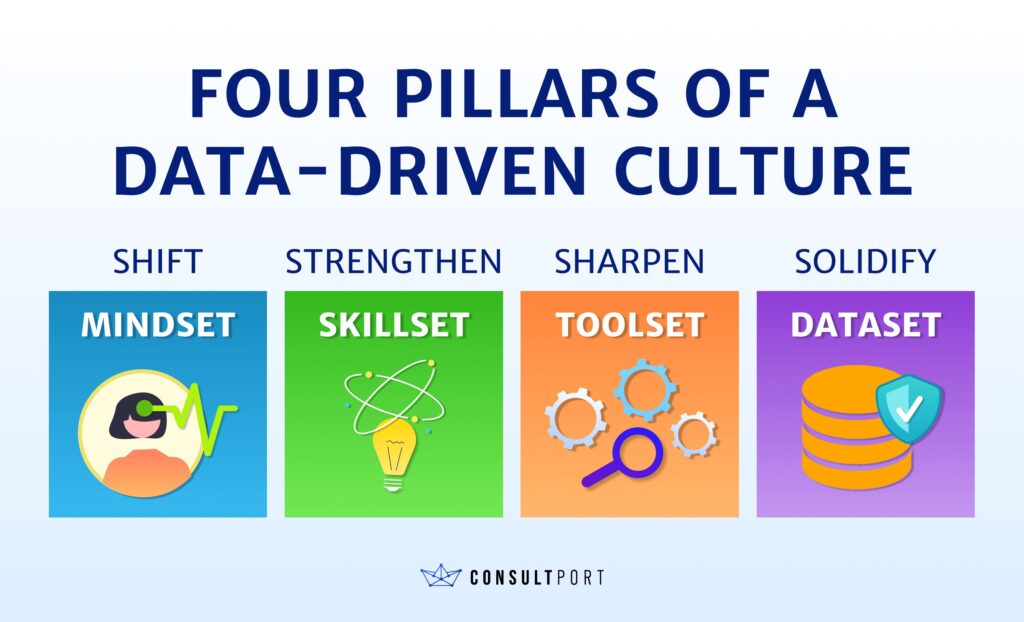What Does It Take to Become a Data-Driven Organization?


Share this article

Doing business is about taking risks. It exists with every decision an organization makes, whether it is strategic, operational or financial decisions.
Taking risks can help an organization land on new opportunities that bring their business to a next level. If one doesn’t take risks, they’ll miss out on potential opportunities for gaining competitive advantage.
In a competitive and unpredictable business environment, data-driven approach is crucial for companies to hone in on key insights to make sound decisions and thrive.
A report by McKinsey concludes that data-driven organizations enjoy earnings before interest, taxes, depreciation, and amortization increase of up to 25 percent. Boston Consulting Group highlighted that the majority of the top 10 innovative companies in the world are data firms.”
There has been a lot of discussion about data-driven organizations recently. So what are the values that a data-driven approach brings? How can companies transform themselves into a data-driven organization? What should they consider becoming a data-driven firm?
Let’s dig deeper on these areas with Consultport.
The first and foremost concern of businesses might be what it would take to develop a data-driven culture. It may sound a bit daunting to make a radical change. A survey cited by Amazon showed that 92.2 percent of companies see culture as the biggest roadblock to becoming a data-driven organization.
There are four main areas to consider when developing a data-centric culture for an organization:

Taking risks can help an organization land on new opportunities that bring their business to a next level. If one doesn’t take risks, they’ll miss out on potential opportunities for gaining competitive advantage.
In a competitive and unpredictable business environment, data-driven approach is crucial for companies to hone in on key insights to make sound decisions and thrive.
A report by McKinsey concludes that data-driven organizations enjoy earnings before interest, taxes, depreciation, and amortization increase of up to 25 percent. Boston Consulting Group highlighted that the majority of the top 10 innovative companies in the world are data firms.”
There has been a lot of discussion about data-driven organizations recently. So what are the values that a data-driven approach brings? How can companies transform themselves into a data-driven organization? What should they consider becoming a data-driven firm?
Let’s dig deeper on these areas with Consultport.
The first and foremost concern of businesses might be what it would take to develop a data-driven culture. It may sound a bit daunting to make a radical change. A survey cited by Amazon showed that 92.2 percent of companies see culture as the biggest roadblock to becoming a data-driven organization.
There are four main areas to consider when developing a data-centric culture for an organization:

Mindset Change
Changing the mindset of staff and making them embrace data is one of the biggest challenges for executives. Both diligence and patience are needed to steer the organization in a new direction.
In an article featured on Forbes, Brent Dykes, data book author and founder of a data storytelling consultancy, suggested the following tactics to shift the mindset to turn one into a more data-driven organization.
Leaders must genuinely believe in every staff’s ability to explore the “next breakthrough by uncovering key insights in data”, it said.
In an article featured on Forbes, Brent Dykes, data book author and founder of a data storytelling consultancy, suggested the following tactics to shift the mindset to turn one into a more data-driven organization.
- Leadership: leaders should have a firm belief in the power of data and show their willingness and determination to embrace data. Leading by example is one of the best approaches to encourage the whole team to adopt the data-drive approach.
- Quick wins: this is a tactic for change management. Showing staff tangible benefits of using data is one of the most effective to persuade and inspire them to embrace data-driven culture.
- Test and Learn: innovative companies like Amazon and Tesla are always open to new ideas, testing, making mistakes and iterating.
Leaders must genuinely believe in every staff’s ability to explore the “next breakthrough by uncovering key insights in data”, it said.
KEY TAKEAWAYS
- Leadership plays a crucial role in deploying a successful data-driven culture for organizations.
- Developing a data-driven culture involves four main pillars: mindset change, skillset improvement, data toolset improvement and dataset solidification.
- Data-driven approach has received increasing attention thanks to benefits that it brings to organizations. They include improved business agility, business process automation, increased sales, better products and services and improved competitive advantages.
Skillset Improvement
In-depth data knowledge and strong skills are essential elements for running a data-driven organization. Executives can consider hiring new talents or improving the data skillset of existing staff.
To hone existing employees’ skills, an organization needs to focus on following areas:

It also highlighted the importance of ongoing monitoring, evaluation and maintenance, led by IT. This helps to make sure analytics performance supports company needs and to guarantee a secure environment for all staff.
According to IBM, leaders should identify how much a data strategy would contribute to a division and avoid the centrally owned data strategy from hindering the widespread adoption.
Different companies with different uses and goals need different technological approaches and tools. A strong data infrastructure is the one that can meet the key requirements of the strategy. It has three main layers:


improved competitiveness: data-driven organizations can make sound predictions about what will happen and therefore will get ahead of their competitors. A good understanding of customers’ needs and preferences will help organizations provide what they need before their competitors.
Better customer retention: information and data about customers also let organizations know what makes them happy and stick around with the brand. Identifying unhappy customers and taking steps to keep them engaged with the brand is also important.
Sustainable improvement: data-driven approach allows businesses to implement best practices and actions with great outcomes, therefore they can continuously improve.
Faster and more reliable decisions: data can reduce the risk level of experiment and testing as well as offer good chances for early success. It also helps save time making decisions and results in better prediction.
Better transparency: data-driven decision making can lead to more reliable and trackable processes by team members, therefore it can lead to higher levels of compliance and transparency.
To hone existing employees’ skills, an organization needs to focus on following areas:
- Data literacy: this can be improved through offering employees with short training courses on basic data skills like how to read and understand data that they consume and use regularly.
- Data storytelling: the next step is to help staff communicate key insights from the data. These skills include analyzing and visualizing data and creating narratives from patterns and trends.
- Expert resources: organizations should also consider hiring data trainers and experts to help their staff become more data-savvy.

Data Toolset Improvement
To establish a culture for data-driven organizations, it is necessary to develop a solid technology foundation with:- Common data language: data book author Dykes suggested that an organization needs a common data language no matter how many data systems they have. They need a “single view of operating metrics that everyone embraces as the real, trusted numbers”.
- Automation: advanced technologies have automated many labor-intensive tasks. Organizations should automate as much of the burden tasks as possible so their staff can be freed up and devote efforts to create more values.
- Process integration: organizations should integrate analytics tools with existing processes and systems to maximize the benefits of them.
Dataset Solidification
The relevance and quality of data is among factors that drive staff’s willingness to embrace data in an organization. To make sure data is useful, trusted and secure, organizations should consider the following areas:- Strategy alignment: the use of data should be aligned with business strategy and core priorities.
- Data governance: to many organizations, data is considered a business asset, therefore its quality must be protected and maintained. However, it needs to balance between oversight and accessibility to ensure that staff do not encounter much hassle when accessing data.
- Data privacy and security: to minimize risks, organizations must ensure that their staff are trained properly on the consequences of data privacy breach and insecurity.
It also highlighted the importance of ongoing monitoring, evaluation and maintenance, led by IT. This helps to make sure analytics performance supports company needs and to guarantee a secure environment for all staff.
Considerations Becoming a Data-driven Organization
Establish a Data Strategy
A strategy ensures companies are moving in the right direction. Therefore, it is crucial for one to become a data-driven organization. Small companies can implement a data strategy without the need for a central unit to manage it. Meanwhile large enterprises can establish a chief data office or unit.According to IBM, leaders should identify how much a data strategy would contribute to a division and avoid the centrally owned data strategy from hindering the widespread adoption.
Develop Strong Data Infrastructure
Data-driven organizations need to develop a strong roadmap and infrastructure for implementation and maintenance of the data strategy.Different companies with different uses and goals need different technological approaches and tools. A strong data infrastructure is the one that can meet the key requirements of the strategy. It has three main layers:
- Data stores: for data processing and storage as well as data access management. Data sources are “sources and destinations” for data products and APIs, according to IBM.
- Data fabric & AI lifecycle: data-driven organizations need a platform for automated data integration, governance as well as the management of data artifacts.
- Data insights and applications: they include tools and blueprints for integrating insights and models derived from data into reports, applications, and solutions, said IBM.
- Data collection: companies can set up many data collection systems themselves or collaborate with a data company.
- Data storage: with the explosion of the volume of data generated and stored, companies need sophisticated but accessible systems and tools. They include data warehouse, data lake, distributed/cloud-based storage system, company server and computer hard disk.
- Data analysis: in this layer, companies use programming languages and platforms to turn data into insights. Data analysis involves three main basic steps: 1) prepare the data, 2) build analytic models, and 3) draw a conclusion from the insights. Widely used software include BigQuery, Cloudera, Microsoft HDInsight and Amazon Web Services.
- Data visualization/output: data can be daunting but it would become so much more effective with clear and concise presentation.

The Value of Becoming a Data-Driven Organization
The development of data science and the explosion of information about customers have resulted in the increasing popularity of data-driven approaches. Why is this so important and what are the values that this approach brings to organizations?
improved competitiveness: data-driven organizations can make sound predictions about what will happen and therefore will get ahead of their competitors. A good understanding of customers’ needs and preferences will help organizations provide what they need before their competitors.
Better customer retention: information and data about customers also let organizations know what makes them happy and stick around with the brand. Identifying unhappy customers and taking steps to keep them engaged with the brand is also important.
Sustainable improvement: data-driven approach allows businesses to implement best practices and actions with great outcomes, therefore they can continuously improve.
Faster and more reliable decisions: data can reduce the risk level of experiment and testing as well as offer good chances for early success. It also helps save time making decisions and results in better prediction.
Better transparency: data-driven decision making can lead to more reliable and trackable processes by team members, therefore it can lead to higher levels of compliance and transparency.
Conclusion
Business executives have become increasingly aware of the importance and values of transforming into a data-driven firm. According to a survey by S&P Global, 90 percent of the respondents agreed that data will be more important. It helps improve business agility, automate business processes, increase sales, develop better products and services as well as empower decision makers and improve firm competitive advantages.
Are you ready to embark on a new journey to transform your business to an innovative and competitive data-driven organization? Don’t hesitate to contact Consulport if you need professional advice, guidance, or consultancy services for your transformation. We are proud to have a pool of talented consultants who can help bring your business to the next level of growth.
Are you ready to embark on a new journey to transform your business to an innovative and competitive data-driven organization? Don’t hesitate to contact Consulport if you need professional advice, guidance, or consultancy services for your transformation. We are proud to have a pool of talented consultants who can help bring your business to the next level of growth.
Share this article
Premium content,
on a weekly basis.
on a weekly basis.
Subscription implies consent to our privacy policy.
×
Subscribe to our newsletters!
Discover our Consultant's Expertise
Ready to get access to the world’s best consultants?
